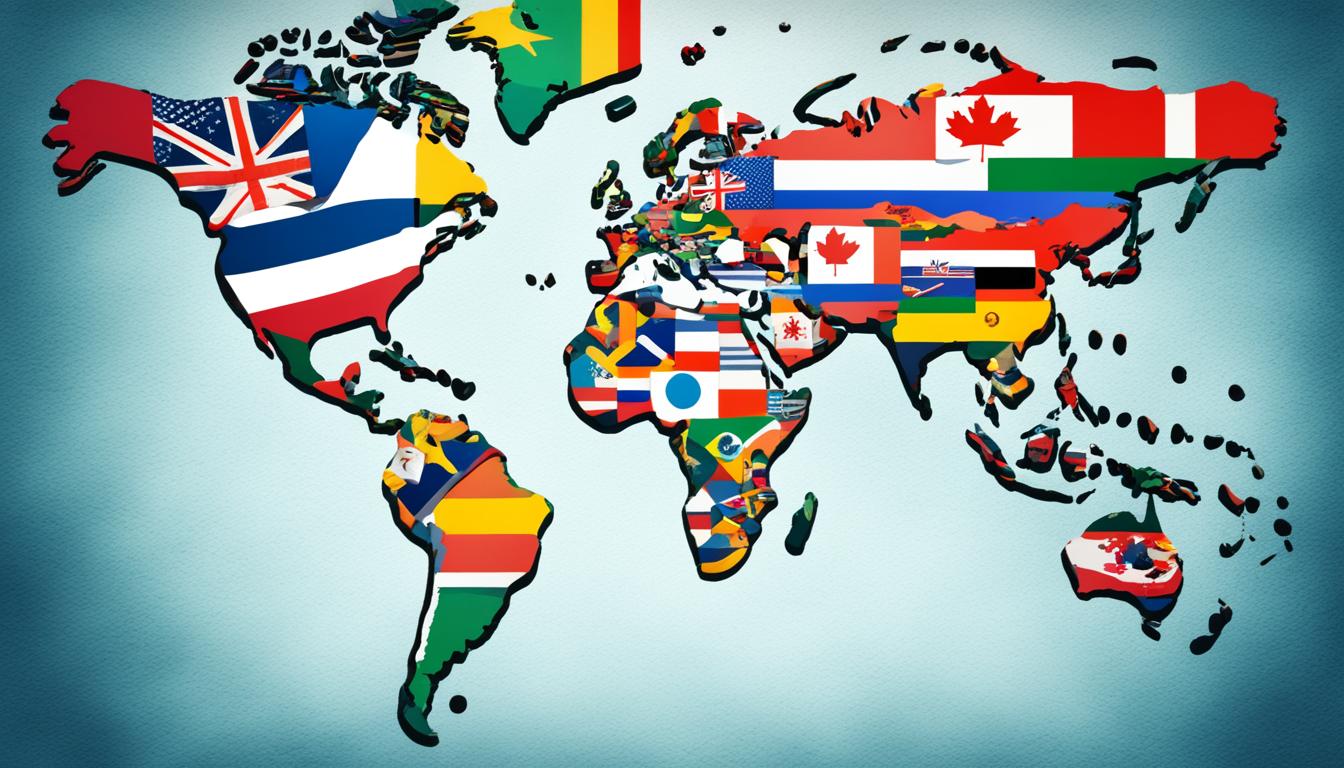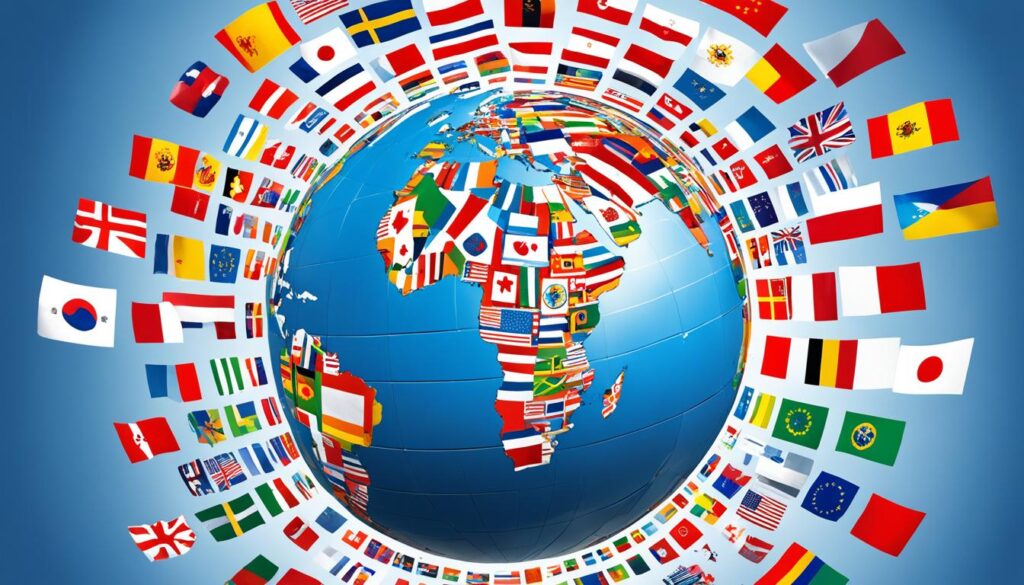
Hello! Want to grow your business worldwide and connect with people around the globe? You're in the right spot. This article will introduce multilingual SEO. It aims to help you boost your website's visibility internationally. This, in turn, will increase your traffic and expand your business's reach.
Multilingual SEO is key to tapping into global markets. It means adjusting your website to fit different languages and countries. By using the right methods, your site will show up in searches across the world. This helps you reach new customers and engage with diverse groups.
Key Takeaways:
- Conduct thorough keyword research across different languages to understand how users are searching for your products or services internationally.
- Create localized content that resonates with your target audience in each language, considering cultural nuances, preferences, and dialects.
- Optimize your website's metadata such as titles, meta descriptions, and tags for each language, incorporating relevant keywords.
- Implement hreflang attributes to show search engines the language and regional targeting of your web pages.
- Build localized backlinks to improve your website's authority and visibility in different linguistic markets.
Keyword Research and Content Localization
Expanding globally requires thorough keyword research to make your website fit different languages and regions. Knowing how users search in various languages helps you create content that speaks directly to them. Tools like Google Keyword Planner, SEMrush, or Ahrefs help find common search phrases and their search volumes.
Understanding search volumes helps pick out top keywords. Including these naturally in your content makes it more relevant and resonates with your audience. Courtesy is key, so consider cultural and local taste, and use the right dialects when crafting localized content.
Creating top-notch, localized content is key to engaging international visitors. This kind of content should meet their specific needs, giving them a unique, tailored experience. Balancing global appeal with local relevance helps you stand out in new markets and boosts your success.
Imagine you're a fashion brand looking into the French market. Through research, you find they search for "robes d'été" and "chaussures à talons". Using these keywords, you can tailor content like blog posts on summer trends and product descriptions for high-heeled shoes to match their interests.
Example:
"Our summer dresses collection features a wide range of styles, from maxi dresses to floral prints. Our robes d'été are perfect for any event, keeping you both stylish and comfy. Pair them with our chic chaussures à talons for an unbeatable summer look."

Popular Keywords in Target Languages
| Language | Target Keyword 1 | Target Keyword 2 | Target Keyword 3 |
|---|---|---|---|
| French | robes d'été | chaussures à talons | accessoires de mode |
| Spanish | vestidos de verano | zapatos de tacón | accesorios de moda |
| German | sommerkleider | high heels | modeaccessoires |
Using these trendy keywords in your content strategy can pull in more visitors via search. Keep track of how well your localized content does and tweak it to follow changing trends.
Metadata Optimization and Hreflang Attribute Implementation
Optimizing metadata is key for better search rankings and showing up in multiple language searches. By tweaking titles, descriptions, and tags for each language, you give search engines more info about your pages.
It's crucial to put in the right keywords when you optimize for different languages. This makes it easier for search engines to know what your content is about. Placing keywords smartly in your metadata can make your website more visible to people worldwide.
Using hreflang tags is also a great way to connect with users in different languages. These tags tell search engines about the languages and locations you're targeting. They help avoid problems with the same content in different places and guide users to the best version of your site for them.
Here is an example of how hreflang tags are implemented:
<link rel="alternate" hreflang="en-us" href="https://www.example.com/page?hl=en-us" /> <link rel="alternate" hreflang="es-mx" href="https://www.example.com/page?hl=es-mx" /> <link rel="alternate" hreflang="fr-fr" href="https://www.example.com/page?hl=fr-fr" />
By working on metadata and hreflang tags, your website can rank better, be seen by more people around the world, and attract visitors interested in your content.

Benefits of Metadata Optimization and Hreflang Attribute Implementation
Improving metadata and using hreflang tags offers several advantages for your website and its global presence:
- Improved search engine rankings: Good metadata helps search engines get what your site is about. A higher rank means more people see your site and visit.
- Enhanced multilingual search results: Hreflang tags help users find the most fitting page based on language and location. This makes the site more useful to them.
- Increased website visibility: Being in search results in multiple languages broadens your audience. More people can find and explore your brand and website.
- Targeted traffic: By using these methods, your site can attract visitors from various language regions. This means better connection and response to your content.
These steps unlock the power of multilingual SEO. They extend your website's reach to many people worldwide.
Conclusion
Today, reaching audiences worldwide is crucial for businesses. Multilingual SEO helps with this. It uses strategies like keyword research and creating content for different regions. This way, you get more visitors and revenue from around the globe.
By focusing on multilingual SEO, you can make your website speak the language of different cultures. It improves how you connect with global customers and shows your brand as trustworthy.
Multilingual SEO also boosts your website's search engine ranking and visibility. It helps you understand what diverse audiences want. By meeting these needs with local strategies, you can outperform others and grow your business.
FAQ
Why is multilingual SEO important for expanding your business globally?
Multilingual SEO is key to growing your business globally. It boosts your visibility and attracts more visitors. This way, you can connect with people all around the world and expand your business.
What are some key strategies for effective multilingual SEO?
There are several important strategies for multilingual SEO. First, do thorough keyword research in different languages. Then, make content that speaks directly to local audiences. Don't forget to optimize your site's metadata and use hreflang tags. Finally, try to get backlinks from sites in your target countries and make sure your site is mobile-friendly.
How can I conduct keyword research in different languages?
To do keyword research in multiple languages, turn to tools like Google Keyword Planner, SEMrush, or Ahrefs. These tools offer insights into what people are searching for online. They help you find the right words to reach your international audience.
Why is localized content important for multilingual SEO?
Localized content matters for multilingual SEO. It speaks to your audience in their own language and style. By considering cultural differences and local tastes, you can make your content more appealing. This increases your site's relevance and connects you with more people.
How can I optimize metadata for multilingual SEO?
Optimizing metadata for SEO across languages is crucial. Make sure each page's metadata matches its content and includes related keywords. This makes your site more visible in search results, helping people find you online.
What are hreflang attributes and how do they impact multilingual SEO?
Hreflang tags tell search engines which language and region your pages target. Using them correctly can prevent issues and help you rank better in searches. They ensure the right content reaches the right audience, boosting your site's SEO performance.
Why is multilingual SEO important for reaching diverse international audiences?
Multilingual SEO opens doors to new markets. By using the right SEO, you can speak to people in various countries and languages. This helps drive growth by allowing you to connect better and sell to a wider audience.











